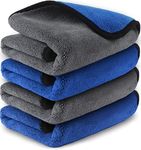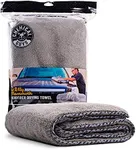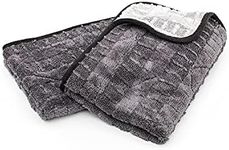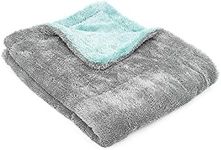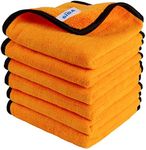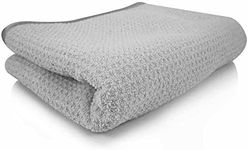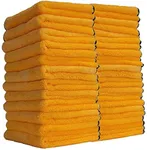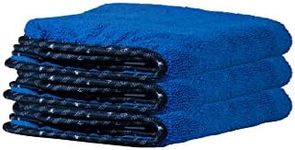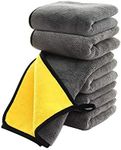Buying Guide for the Best Microfiber Towels For Cars
Choosing the right microfiber towel for your car can make a big difference in how well you clean, dry, or detail your vehicle. Microfiber towels are popular because they are gentle on surfaces, highly absorbent, and effective at picking up dirt without scratching. When shopping for microfiber towels, it's important to understand the key features that affect their performance and suitability for different car care tasks. By focusing on the right specifications, you can ensure you get towels that match your needs, whether it's for washing, drying, waxing, or interior cleaning.GSM (Grams per Square Meter)GSM measures the density or thickness of the microfiber towel. A higher GSM means the towel is thicker and more absorbent, while a lower GSM indicates a lighter, thinner towel. Towels with a GSM between 200-350 are usually lightweight and good for general cleaning or interior surfaces. Medium GSM towels, around 350-600, are versatile and work well for drying and buffing. High GSM towels, above 600, are plush and best for delicate tasks like final drying or waxing. To pick the right GSM, think about your main use: lighter towels for quick cleanups, medium for all-purpose use, and high GSM for gentle, scratch-free finishing.
Blend Ratio (Polyester/Polyamide)The blend ratio tells you the mix of polyester and polyamide (nylon) in the towel. Polyester provides structure and cleaning power, while polyamide adds softness and absorbency. Common blends are 80/20 or 70/30. A higher polyamide content (like 70/30) means a softer, more absorbent towel, which is better for delicate surfaces and drying. An 80/20 blend is more durable and suitable for general cleaning. Choose a higher polyamide blend if you want extra softness for paintwork, and a higher polyester blend for tougher cleaning jobs.
Pile Height (Nap Length)Pile height refers to how long the fibers are on the towel's surface. Short pile towels have a flat, tight weave and are good for removing wax, polish, or for glass cleaning because they leave fewer streaks. Medium pile towels are more versatile and can handle both cleaning and drying. Long pile towels are fluffy and gentle, making them ideal for drying and for use on sensitive paint. If you need a towel for buffing or glass, go for short pile; for drying or delicate surfaces, long pile is best; and for all-around use, medium pile is a safe choice.
Edging TypeThe edging of a microfiber towel can be stitched, silk-banded, or edgeless. Stitched edges are durable but can sometimes scratch delicate surfaces if the stitching is rough. Silk or satin-banded edges are softer and reduce the risk of scratching. Edgeless towels are laser-cut and have no seams, making them the safest for sensitive paintwork. If you are concerned about scratches, especially on glossy or dark paint, choose silk-banded or edgeless towels. For general cleaning, stitched edges are usually sufficient.
SizeMicrofiber towels come in various sizes, from small (about 12x12 inches) to large (up to 24x36 inches or more). Smaller towels are easier to handle for interior cleaning or spot detailing, while larger towels are better for drying big surfaces like the car body. Consider what tasks you'll use the towel for: small for interiors and tight spaces, medium for general use, and large for drying or covering more area quickly.
ColorColor might seem like a cosmetic choice, but it can help you organize towels for different tasks to avoid cross-contamination. For example, you might use one color for wheels, another for paint, and another for interiors. This helps prevent dirt or chemicals from one area from damaging another. Pick different colors if you want to keep your car care routine organized and safe.

